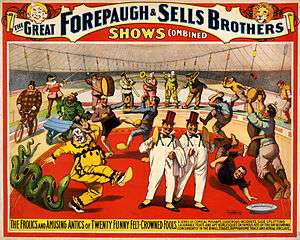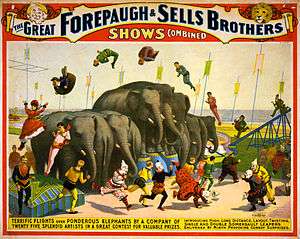Adam Forepaugh
Adam John Forepaugh (February 28, 1831 - January 22, 1890) was an American entrepreneur, businessman, and circus owner.

Forepaugh owned and operated a circus from 1865 through 1890 under various names including Forepaugh's Circus, The Great Forepaugh Show, The Adam Forepaugh Circus, and Forepaugh & The Wild West.
Biography
Forepaugh was born into poverty in Philadelphia, Pennsylvania, to John A. Forepaugh, a butcher, and Susannah Heimer. He began working in a butcher shop at age 9, earning just $4 a month.[1] After a short time Forepaugh "ran away" to Ohio where he got into cattle appraising and managing stage lines. He moved to New York City and began a business dealing in horses and other livestock. Eventually he became the largest purveyors of horses in the state, and earned a reputation as an expert judge of horses.[2] He made a fortune during the Civil War selling horses to the U.S. government.
In 1864, Forepaugh sold 44 horses to John V. "Pogey" O'Brien for $9,000 so he could start the Tom King Excelsior Circus. When O'Brien could not repay the loan, Forepaugh assumed partial ownership of the circus, getting him into the circus business, where he would make his most lasting impression. The next year, he and O'Brien purchased the Jerry Mabie Menagerie and created two circuses with their combined assets: The Great National Circus and the Dan Rice Circus. Forepaugh soon sold the Great National Circus and put the Dan Rice Circus under his own name.
Forepaugh was different from most of his fellow circus operators. Already independently wealthy when he entered the circus business, he was much less a showman and much more a businessman—a stark contrast to P. T. Barnum and the Ringling Brothers. He was intimately involved in all aspects of the circus business. He would regularly seat himself at the main entrance into the circus, a vantage point that ensured that his face was seen by all and from which, it was rumored, he could estimate the night's receipts to hold his employees accountable.[3] Through the 1870s and into the 1880s, Forepaugh and P. T. Barnum had the two largest circuses in the nation. Forepaugh actually had more animals than Barnum and generally paid higher salaries to the much-favored European talent. The two men constantly fought each other over rights to perform in the most-favored venues.
They signed truces in 1882, 1884, and 1887, dividing the country into exclusive territories to avoid disputes. But at least twice, they decided to pool their resources and perform together. In 1880, Forepaugh and Barnum combined their shows for a Philadelphia engagement. In 1887, Forepaugh obtained permission to perform in Madison Square Garden, a venue that Barnum considered to be exclusively his but had forfeited by his neglect to renew his contract.[3] A compromise was negotiated, and once again the two circuses presented a combined performance in the largest circus performance to date.[4]
In 1889, Forepaugh sold his circus acts to James Anthony Bailey and James E. Cooper and sold his railroad cars to the Ringling Brothers. The Ringlings used the equipment to transform their circus from a small animal-powered production to a huge rail-powered behemoth, which later purchased the Barnum & Bailey Circus. Thus, in liquidating his circus assets, he indirectly contributed to the demise of his arch-rival.
Forepaugh died January 20, 1890, in Philadelphia during the 1889–1890 flu pandemic and is buried in the family vault at Laurel Hill Cemetery.[5] Many local charities and churches in the Philadelphia area benefited from his estate, including Temple University, Morris Animal Refuge, St. Agnes, St. Luke's and Children's Medical Center.
Legacy
He had one child, Adam Forepaugh, Jr., an elephant trainer. He once commented that he would prevail over Barnum because "I have a boy and Mr. Barnum has none. My show will outlast his." Ultimately, although Adam, Jr. worked in his father's circus and executed his estate, he did not follow him in the circus business.
Business practices
The American circus business in this period was known for its unscrupulous business practices—practices of which Forepaugh was a willing participant. Forepaugh was also noted for his business acumen and marketing prowess, which made his circus profitable every year except one.[3]
Before entering the circus business, Forepaugh had worked as a horse trainer and animal dealer in Pennsylvania, Ohio, and New York. Other than his circus shows’ profits, Forepaugh’s horse selling enterprise during the Civil War became his most lucrative business venture. “The civil war [sic] made horses very valuable, and Mr. Forepaugh secured contracts to furnish them to street railway companies” which would transport the horses via train to the South. Forepaugh encountered a problem: horses were being used by both the North and the South, and this made young and strong animals scarce. “He was obliged to devise a plan to make old ‘nags’ as good as new” before selling them at a much higher price and earning a significant profit.[2]
One of the most famous examples of Forepaugh's unscrupulous methods was his rivalry with Barnum over Barnum's white elephant. P. T. Barnum had purchased, at great cost, an ostensibly white elephant, only to discover upon delivery that it was pink, with great spots. Forepaugh heard of this and sniffed an opportunity to one-up Barnum. He whitewashed a regular gray elephant, called it the "Light of Asia", and marketed it as the real thing, not like Barnum's cheap imitation. To further illustrate the spirit of the business dealings between the two, a reporter who managed to sneak up and remove some of the whitewash from the "Light of Asia" to prove Forepaugh's fraud was able to sell this information to Barnum, instead of writing a story about it for his newspaper.[6]
Some of Forepaugh's methods were truly innovative, however. He was the first circus operator to separate the menagerie from the big ring in order to attract church goers who might be leery of the "sinful" attractions of circus acts, yet still desirous to see the exotic animals in the menagerie.[7]
Innovations
Forepaugh was responsible for many innovations in circus history, which influenced circuses for many years.
- He was the first to incorporate a "Wild West Show" into his circus.
- In 1869, he was the first to use two separate "bigtop" tents at the same time, one for the circus performance and the other for the menagerie.
- In search of new talent, he sponsored a $10,000 beauty contest in 1881, looking for the "most beautiful woman in America". The winner was Louise Montague, a 21-year-old New York City actress blessed with a "charming blue eye" and "... magnificent teeth, which she shows to advantage in conversation".[8] Many believe this was the first "beauty pageant" in America.
- He hired an African-American elephant trainer named Ephraim Thompson in a time when blacks rarely had positions of such stature.
Lore
Memory of Forepaugh's circuses continued into the early 20th century. As late as 1928, the poet Vachel Lindsay wrote, "And elephants Adam Forepaugh bred/ In the wilds of the U. S. A./ In his happy Yankee way."[9]
The famous "sucker" quote
The quote "There's a sucker born every minute, but none of them ever die" is often attributed to P. T. Barnum. The source of the quote is most likely famous con-man Joseph ("Paper Collar" Joe) Bessimer. Forepaugh attributed the quote to Barnum in a newspaper interview in an attempt to discredit him. However, Barnum never denied making the quote. It is said that he thanked Forepaugh for the free publicity he had given him.
Poster for Forepaugh & Sells Brothers
References
- Traber, J Milton "Adam Forepaugh's Life" Billboard (Cincinnati, OH) 8, October 1910: 13-24. https://archive.org/stream/billboard22-1910-10#page/n92/mode/1up/.
- "Death of Adam Forepuagh" New York Times (New York City) 24 January 1890.
- Albrecht, Ernest. American National Biography Online. Oxford University Press, 2000. s.v. "Forepaugh, Adam." (registration required)
- Wilmeth, Don B and Tice L Miller "Adam Forepaugh" Cambridge Guide to American Theatre (New York: Press Syndicate of the University of Cambridge, 1996): 158.
- "Death Of Adam Forepaugh. The Veteran Showman Falls a Victim to Influenza And Pneumonia". The New York Times. January 24, 1890. Retrieved 2011-09-12.
Adam Forepaugh, the veteran circus manager, died late last night at his residence in this city. He had been ailing for some time past. ...
- Wallace, Irving. The Fabulous Showman: The Life and Times of P. T. Barnum. New York: Alfred A. Knopf, 1959: 297.
- Edited by Allen Johnson and Dumas Malone (1946). "Forepaugh, Adam". Dictionary of American Biography. V. New York: Charles Scribner's Sons. p. 522.CS1 maint: extra text: authors list (link)
- Police Gazette, April 23, 1881
- Lindsay, Vachel. "Every Soul Is a Circus." Poetry. 33. no. 1 (1928): 6.
External links
| Wikimedia Commons has media related to Adam Forepaugh and Sells Brothers. |



